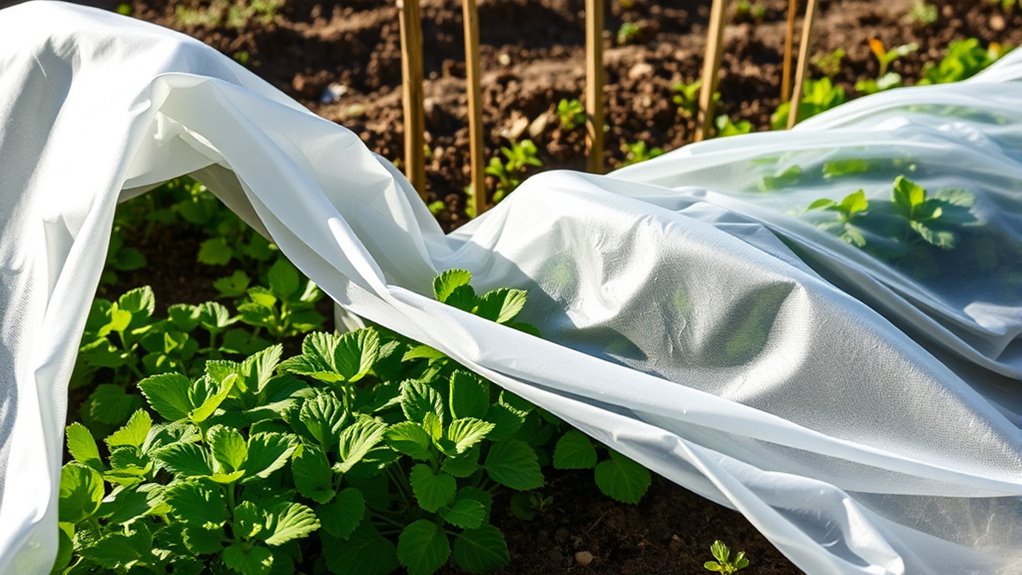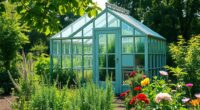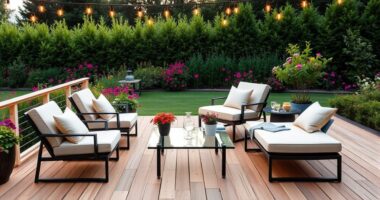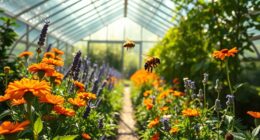When it comes to protecting your plants, I've found some excellent row cover materials. Agfabric Plant Covers are lightweight and breathable, while Jevrensch's Ultra Fine Garden Netting is durable and great for allowing sunlight through. A 4ft x 300ft weed barrier fabric efficiently controls weeds. For freeze protection, I love the 10 pack of 50FT plant covers. Each option suits specific needs, making it easy to bolster your garden. Stick around to explore the best choices further!
Key Takeaways
- Agfabric Plant Covers are lightweight and breathable, providing frost protection while allowing air and moisture to reach plants, ideal for short-term use.
- Jevrench Durable Ultra Fine Garden Netting offers long-lasting pest protection with its thick mesh design, allowing sunlight and rain, suitable for various garden areas.
- Garden Landscape Fabric Weed Barrier effectively inhibits weed growth while permitting water and nutrients, ensuring durability for long-term garden use.
- 10 Pack 50FT Plant Covers are versatile, reusable, and protect against frost and wildlife, making them great for different plant sizes and shapes.
- Garden Netting Pest Barrier is lightweight yet durable, UV-resistant, and effectively blocks pests while facilitating proper air and light circulation for healthy plant growth.
Agfabric Plant Covers for Vegetables (7×50, 0.55oz)
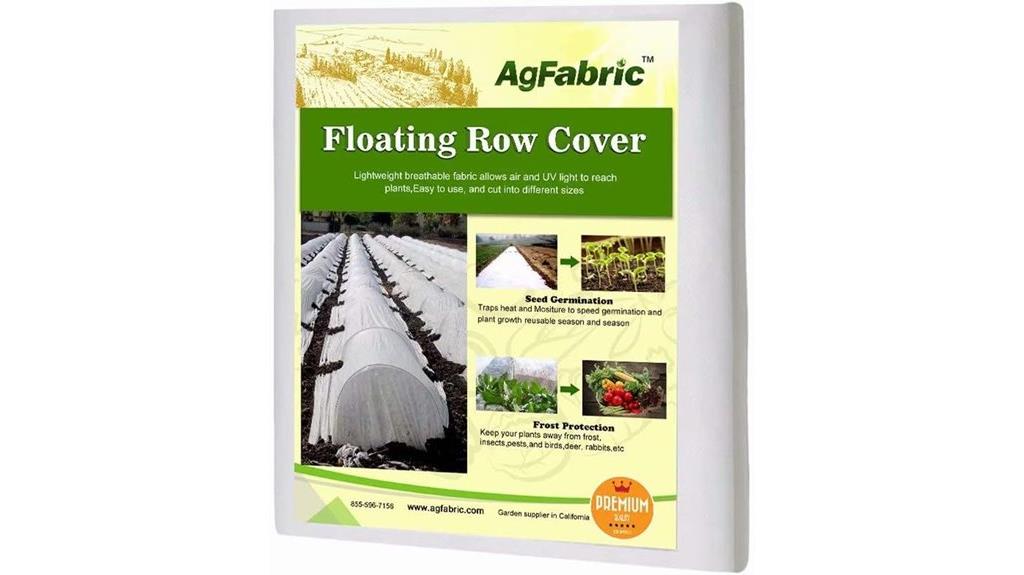
If you're a gardener looking to protect your vegetables from harsh weather and pests, Agfabric Plant Covers might be just what you need. Measuring 7×50 inches and made from lightweight, breathable 0.55oz polypropylene, these covers are easy to use and effective. I simply place them over my plants and secure them with stones or soil. They allow air and moisture in while shielding my tomatoes and peppers from frost and pests. However, I've noticed they can be fragile, so I recommend keeping an eye on them during extreme weather. Overall, they've considerably extended my growing season!
Best For: Gardeners looking to protect their vegetables from harsh weather and pests while extending their growing season.
Pros:
- Lightweight and breathable fabric allows air and moisture to reach plants.
- Effective at protecting against frost, wind, and pests like deer and rabbits.
- Easy to install and secure using stones, soil, or staples.
Cons:
- Can be fragile, requiring potential re-purchase after a season.
- May not withstand severe winter conditions effectively.
- Some users desire additional anchors for better security in windy conditions.
Jevrench Durable Ultra Fine Garden Netting (4ft x 25ft)
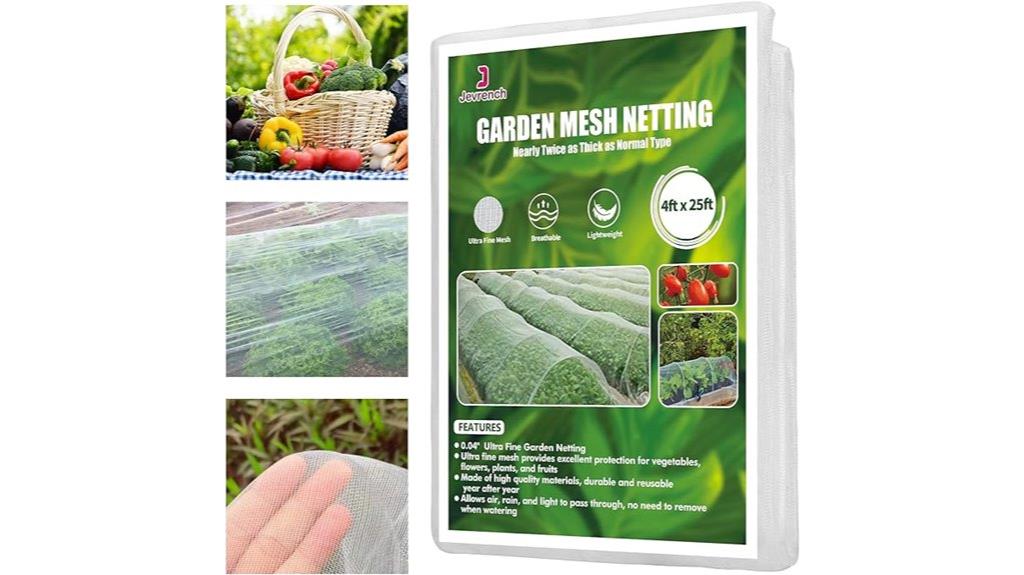
Jevrench Durable Ultra Fine Garden Netting (4ft x 25ft) is an excellent choice for gardeners who want to protect their plants from pests while still allowing essential sunlight and rain to nourish them. Made from high-quality transparent mesh PE material, it's twice as thick as standard options, ensuring durability for 3-5 years. The ultra-fine mesh design permits air and water through, making it perfect for all growing seasons. I love how I can easily cut it to fit different areas of my garden, and it's proven effective in keeping pests at bay. Plus, Jevrench offers great customer support if needed!
Best For: Gardeners looking for a durable and effective solution to protect plants from pests while allowing sunlight and rain to nourish them.
Pros:
- Made from high-quality, thicker mesh material for enhanced durability (3-5 years).
- Ultra-fine mesh design allows sunlight, rain, and air to pass through easily.
- Versatile and can be cut to fit various gardening needs.
Cons:
- Requires secure placement to prevent displacement by wind.
- May need periodic maintenance to ensure longevity.
- Some users may find it challenging to install in larger areas without help.
4ftx300ft Garden Landscape Fabric Weed Barrier
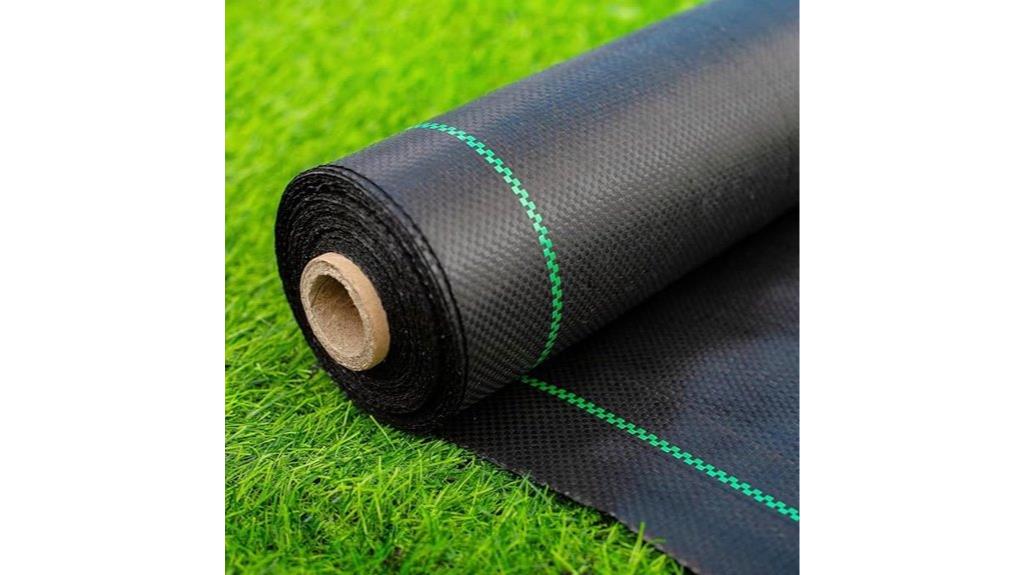
The 4ft x 300ft Garden Landscape Fabric Weed Barrier stands out as an excellent choice for gardeners seeking effective weed control without the hassle. Made from 100% polypropylene, this heavy-duty, woven fabric allows for high permeability while inhibiting weed growth. I love how it reduces my weeding time considerably, making gardening much more enjoyable. Its versatility means I can use it in various settings, from vegetable patches to flower beds. Plus, it's durable and designed for long-term use, so I don't have to worry about frequent replacements. Installation is simple, making it a must-have for any gardener.
Best For: Gardeners looking for an effective and durable solution to control weeds in various gardening environments.
Pros:
- High permeability: Allows water and nutrients to reach the soil while preventing weed growth.
- Durable construction: Thick, heavy-duty fabric ensures long-term use and reduces the frequency of replacements.
- Easy installation: Simple to lay down and secure, making it accessible for gardeners of all skill levels.
Cons:
- Water retention concerns: Some users report issues with water drainage under the fabric.
- Material longevity: A few customers have expressed concerns regarding the fabric's lifespan with prolonged exposure to the elements.
- Initial setup effort: Although installation is easy, it may require some physical effort to secure the fabric properly.
10 Pack 50FT Plant Covers for Freeze Protection
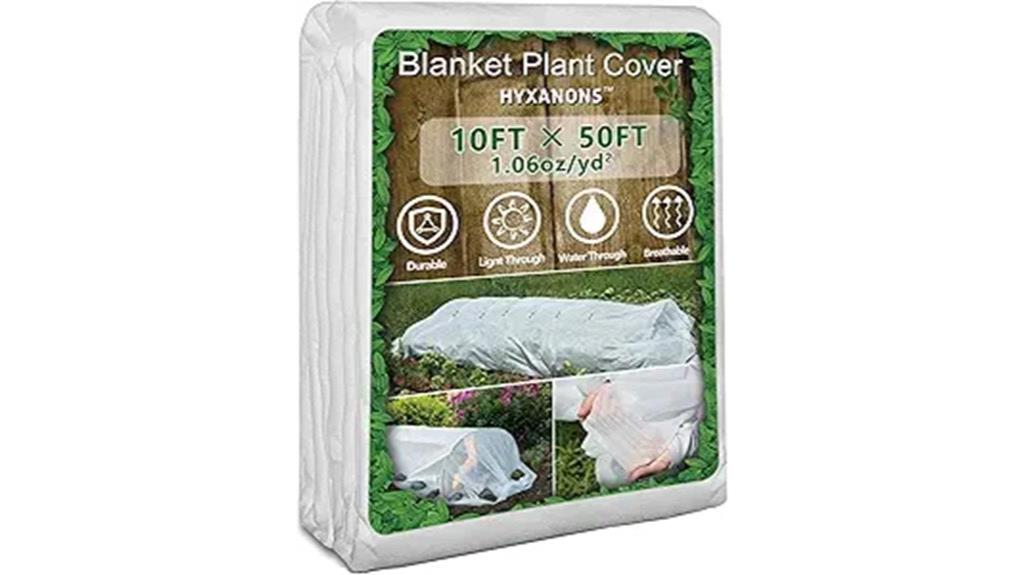
Pack 50FT Plant Covers are an excellent choice for gardeners looking to protect their plants from harsh weather conditions. These versatile covers measure 10 by 50 feet and can easily be trimmed to fit various plants like vegetables and shrubs. Made from sturdy, lightweight fabric, they guard against frost, freezing temperatures, and even pesky wildlife. I love that I can layer them for extra protection and secure them with simple materials like stones or clips. Plus, they're reusable, allowing air and moisture in, which keeps my plants healthy. I've seen great results even during extreme cold, making them a must-have for any garden.
Best For: Gardeners looking for effective protection for their plants against frost, freezing temperatures, and wildlife.
Pros:
- Sturdy and durable fabric provides excellent frost and freezing protection.
- Reusable and allows air, water, and moisture to reach plants, promoting healthy growth.
- Versatile design allows for customization and layering for varied plant sizes and needs.
Cons:
- Requires secure placement which might need additional materials (e.g., stones or clips).
- May need trimming to fit specific plant sizes, which could be inconvenient for some users.
- Effectiveness may vary based on local weather conditions and specific plant types.
Jevrench Durable Ultra Fine Garden Netting (4ft x 25ft)
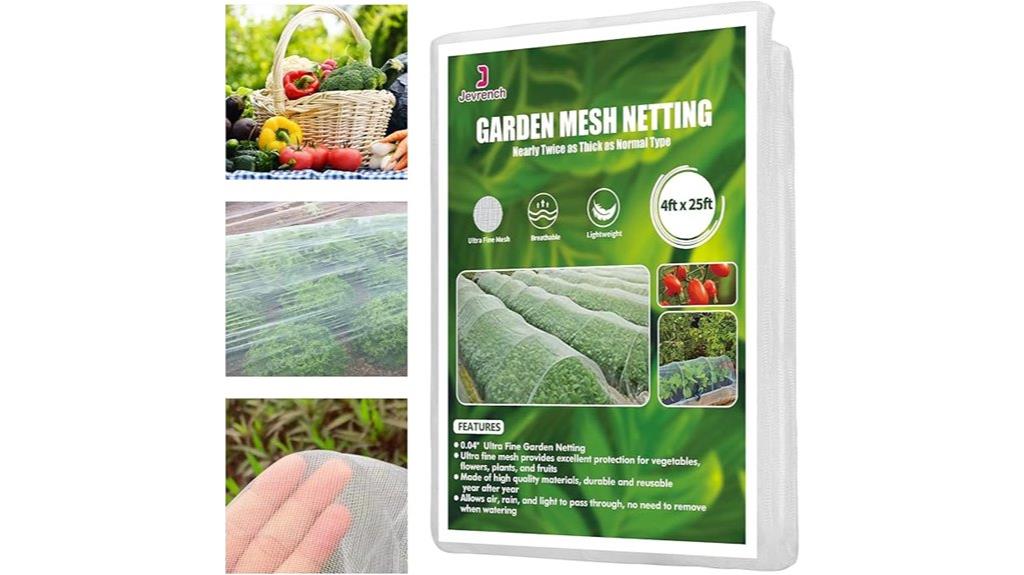
If you're looking for a reliable way to safeguard your garden from pests while still allowing essential sunlight and air to nourish your plants, Jevrench Durable Ultra Fine Garden Netting is an excellent choice. This 4ft x 25ft netting creates a strong barrier against unwanted visitors, ensuring your plants thrive and yield better. Made from high-quality, transparent mesh PE material, it's twice as thick as typical options, offering exceptional durability. Plus, its ultra-fine mesh lets sunlight and rain through while being easy to cut for various garden needs. I've found it effective, and I appreciate Jevrench's customer support too!
Best For: Gardeners looking to protect their plants from pests while allowing sunlight and air to reach them.
Pros:
- Durable material: Made from high-quality, thick PE mesh that lasts 3-5 years with proper care.
- Easy to use: The netting can be cut to fit various garden sizes and shapes, making it versatile for different gardening needs.
- Effective pest barrier: Users report significant success in keeping pests away from their crops.
Cons:
- Wind displacement: Some users recommend securing the netting well to prevent it from being blown away by strong winds.
- Limited visibility: The mesh, while transparent, may slightly obscure the view of plants underneath.
- Size limitations: The fixed dimensions (4ft x 25ft) may not suit all garden sizes without additional purchases or cutting.
Garden Netting Pest Barrier for Garden Protection
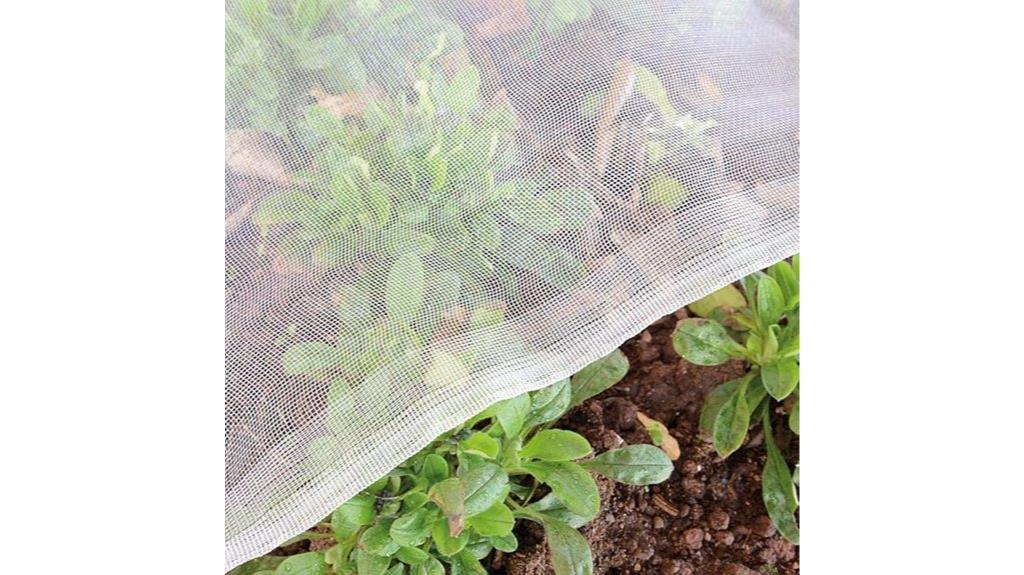
For gardeners seeking an effective solution to protect their plants from pests, the Garden Netting Pest Barrier stands out with its high-density polyethylene construction. This 4×10 fine bug netting is perfect for safeguarding your vegetables, flowers, and fruits from pesky insects like aphids and cicadas. I love how lightweight yet durable it is, allowing air, water, and light to pass through effortlessly. Plus, it's adaptable—anchoring it with rocks or using garden hoops keeps it stable. With a 4.5-star rating and a three-year warranty, it's become an essential part of my garden protection toolkit. Highly recommend!
Best For: Gardeners looking for an effective, lightweight solution to protect their plants from pests while allowing air, water, and light to pass through.
Pros:
- Made from durable, UV-resistant high-density polyethylene, ensuring long-lasting use.
- Versatile application for various gardening needs, including protection from deer, rabbits, and birds.
- Easy to use and install, with the option to cut into any size or anchor for stability.
Cons:
- Some users have reported concerns about the product size being smaller than expected.
- A few customers noted potential issues with mold if not properly maintained.
- Limited effectiveness against larger pests or severe infestations without additional support.
Plant Covers Freeze Protection Frost Blankets for Outdoor Plants
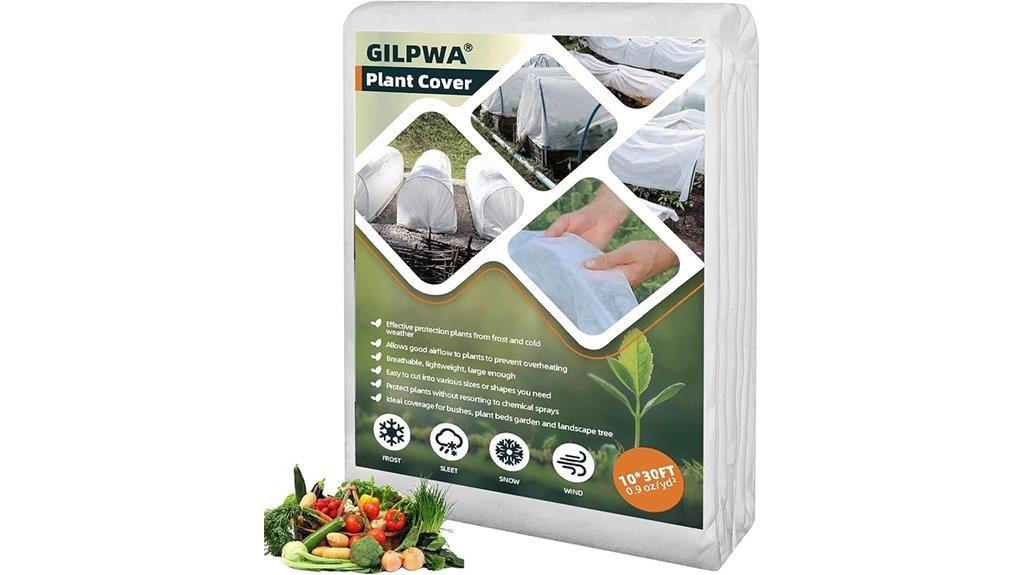
When it comes to protecting your outdoor plants from harsh weather, the Plant Covers Freeze Protection frost blankets are a must-have for any gardener. Measuring 10 x 30 feet, this lightweight, breathable fabric guards against frost, snow, and pests while still allowing air and moisture to reach your plants. I've found it incredibly useful for delicate transplants during cold snaps. Plus, it's easy to cut to size and secure with soil or stones. Users rave about its durability and effectiveness, making it a great investment for both novice and seasoned gardeners alike. Don't let your plants suffer—give them the protection they deserve!
Best For: This product is best for gardeners looking to protect their outdoor plants, vegetables, and shrubs from harsh weather conditions.
Pros:
- Breathable and lightweight fabric allows air and moisture to reach plants while protecting them from frost, snow, and pests.
- Large size (10 x 30 FT) can cover extensive areas and be easily cut to fit various applications.
- Durable and UV stabilized material reduces the risk of tears and is reusable for multiple growing seasons.
Cons:
- May require additional support, such as hoops, for optimal coverage and plant growth.
- Effectiveness can vary depending on the specific weather conditions and plant types.
- Some users might find the initial investment cost higher compared to other protective options.
Plant Covers Freeze Protection 10 ft x 30 ft Garden Fabric
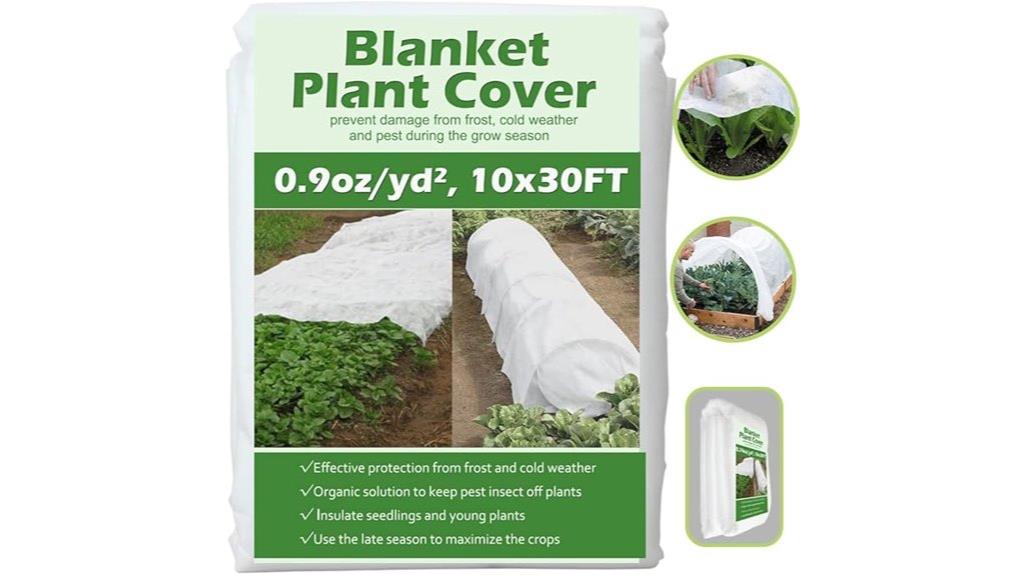
Protecting your plants from harsh weather is essential for any gardener, and the Plant Covers Freeze Protection 10 ft x 30 ft Garden Fabric is an excellent choice for those serious about their green thumbs. This lightweight, breathable polypropylene fabric covers up to 300 sq. ft., ensuring your plants stay warm while still getting sunlight. I love how it acts as a barrier against frost, pests, and even intense sunlight. Just drape it over your plants before sunset to capture heat, and it's easy to secure with soil or stones. Plus, it's durable and has great customer ratings, making it a reliable option!
Best For: Gardeners looking for an effective solution to protect their plants from frost, pests, and extreme weather conditions.
Pros:
- Lightweight and breathable fabric allows sunlight to penetrate while providing protection from frost.
- Versatile usage for aiding in germination, supporting seedling growth, and shielding plants from animals.
- Easy to install and secure, making it convenient for quick setup before cold weather.
Cons:
- Some users reported sizing issues that may not fit all garden layouts perfectly.
- Durability concerns over time, with some needing additional support like hoops to prevent contact with plants.
- Requires removal during warmer temperatures, which may be inconvenient for some gardeners.
KYATE Plant Covers for Freeze Protection

KYATE Plant Covers are ideal for gardeners looking to safeguard their plants from harsh winter conditions. Measuring 10 feet by 30 feet, these covers are made from lightweight, breathable non-woven polypropylene fabric. I love how I can cut them to fit various plants while still providing excellent protection against frost, sun, wind, and pests. They allow sunlight in while keeping plants warm, promoting rapid germination and extended growing seasons. Just loosely cover your plants and secure them with stones or staples. Plus, their sturdy construction assures me that my plants will thrive even in challenging climates.
Best For: Gardeners seeking effective protection for their plants against harsh winter conditions.
Pros:
- Lightweight and breathable fabric promotes healthy plant growth while providing protection.
- Versatile size can be cut to fit different plant shapes and sizes.
- Supports germination and extends the growing season into early spring and late autumn.
Cons:
- Some users report inadequate protection in specific climates, such as Houston.
- Requires proper securing methods to ensure effectiveness against wind and pests.
- May need additional support like hoops for larger plants to prevent contact with the cover.
Garden Netting Pest Barrier (10 ft x 33 ft Ultra Fine Mesh)
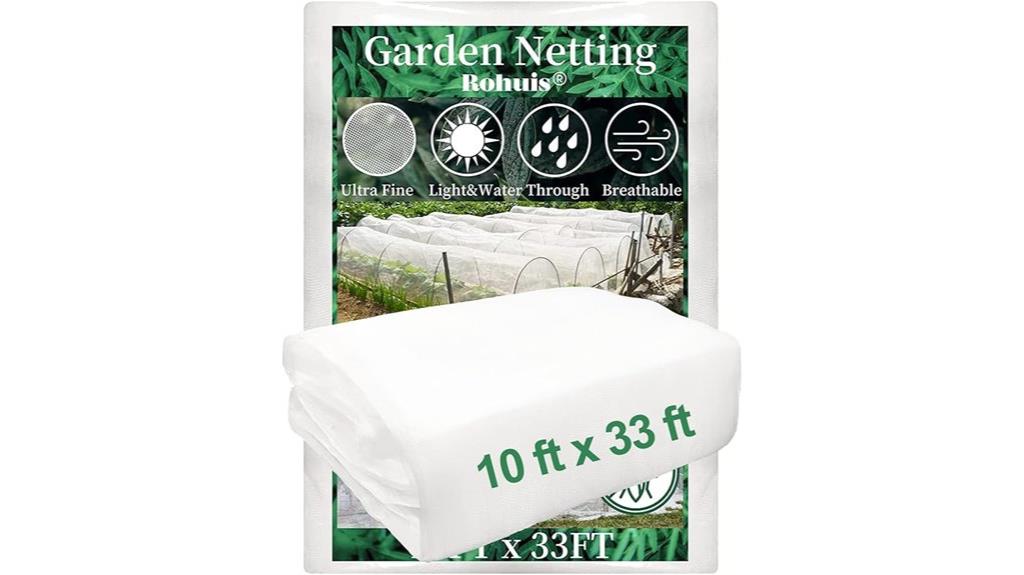
If you're looking for a reliable way to safeguard your garden, the Garden Netting Pest Barrier (10 ft x 33 ft Ultra Fine Mesh) is an excellent choice. This high-quality polyethylene mesh protects your vegetables, fruits, and flowers from pesky insects, critters, and birds. I love how it allows air, water, and sunlight to nourish my plants without needing removal for watering. Plus, it's easy to cut to size and secure with pegs or stones. While some users report durability issues, many praise its effectiveness. Overall, it's a versatile tool that keeps my garden thriving and pest-free!
Best For: Garden enthusiasts looking to protect their plants from pests while allowing essential elements like air and sunlight to reach them.
Pros:
- Allows air, water, and sunlight to reach plants without removal for watering.
- Easy to cut and secure to fit various garden sizes and shapes.
- Versatile use for both gardening and as a mosquito net.
Cons:
- Some users report durability issues, with the netting tearing easily.
- Mixed reviews on effectiveness, with some users finding it less effective against certain pests.
- Requires additional securing with pegs or stones, which may not be convenient for all users.
Towallmark Geotextile Landscape Fabric (3ft x 300ft)
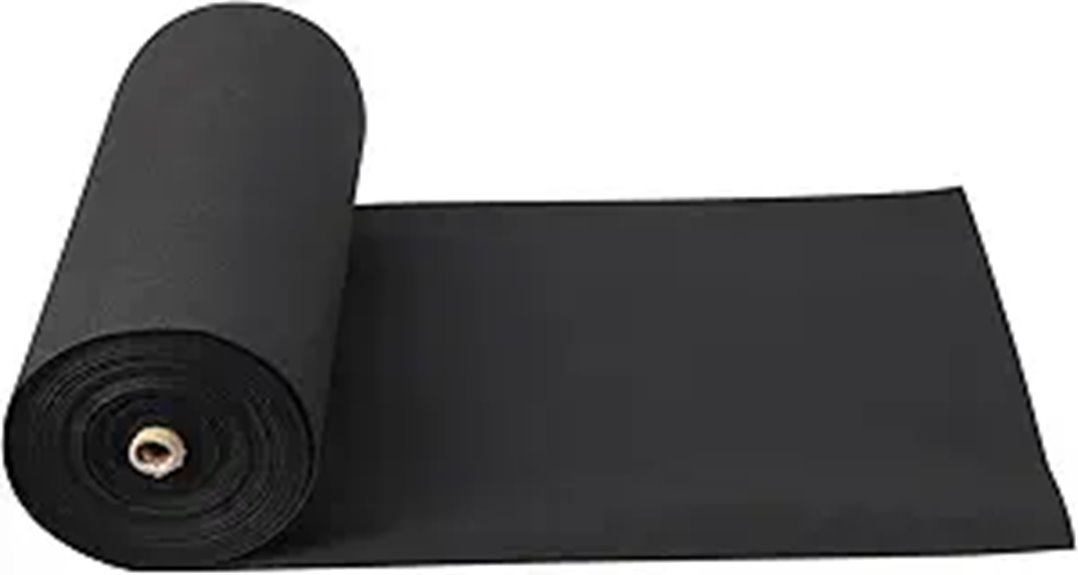
For gardeners and landscapers seeking robust erosion control, the Towallmark Geotextile Landscape Fabric (3ft x 300ft) stands out with its impressive 6oz density and high tensile strength. Made from durable PP non-woven material, it's perfect for driveway stabilization, French drains, and erosion control projects. I love that it's heavy-duty and tear-proof, ideal for high traffic areas. Installation is a breeze—just roll it out and cut it to size. Plus, with a lifespan of at least 30 years, it's a solid investment. Just keep it out of direct sunlight for peak performance, and you're set for years to come!
Best For: Gardeners and landscapers looking for a heavy-duty solution for erosion control and drainage stabilization projects.
Pros:
- Durable and high-strength: Made from 6oz PP non-woven material, suitable for heavy loads and high traffic areas.
- Long-lasting: Expected lifespan of at least 30 years with proper installation and maintenance.
- Easy installation: Can be easily rolled out and cut to size for various applications.
Cons:
- Not a weed barrier: Designed primarily for erosion control and drainage, it does not prevent weed growth.
- Requires protection from sunlight: Should be buried under mulch or gravel if used as ground cover to avoid degradation.
- Limited aesthetic use: Primarily functional, may not meet visual landscaping needs for decorative purposes.
Garden Mesh Netting Kit with Hoops & Clips
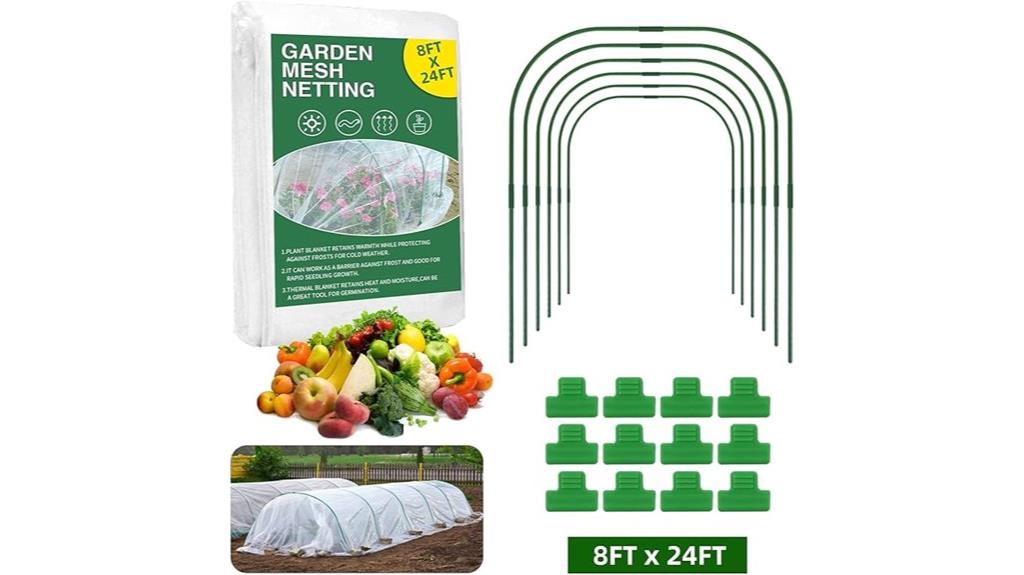
The Garden Mesh Netting Kit with Hoops & Clips is an ideal choice for gardeners seeking effective protection for their plants from small animals and pests. With dimensions of 8×24 ft, this kit includes high-quality superfine mesh that's tough and durable. The plastic-coated steel hoops make setup a breeze, taking just five minutes to assemble. I've found it perfect for vegetables, fruits, and even potted plants. While some customers noted minor issues with clips and netting quality, its overall effectiveness in keeping pests at bay makes it a worthwhile investment for any garden enthusiast like myself.
Best For: Gardeners looking for effective protection against small animals and pests for their plants.
Pros:
- Easy to assemble within five minutes with sharp tips for easy soil insertion.
- Made from high-quality, durable mesh that effectively blocks pests.
- Versatile application for a variety of plants, including vegetables and fruits.
Cons:
- Some customers reported issues with the quality of the netting.
- Clips can be difficult to use, leading to frustration during installation.
- Durability concerns noted in extreme weather conditions and animal interactions.
Plant Covers Freeze Protection Frost Cloth for Garden
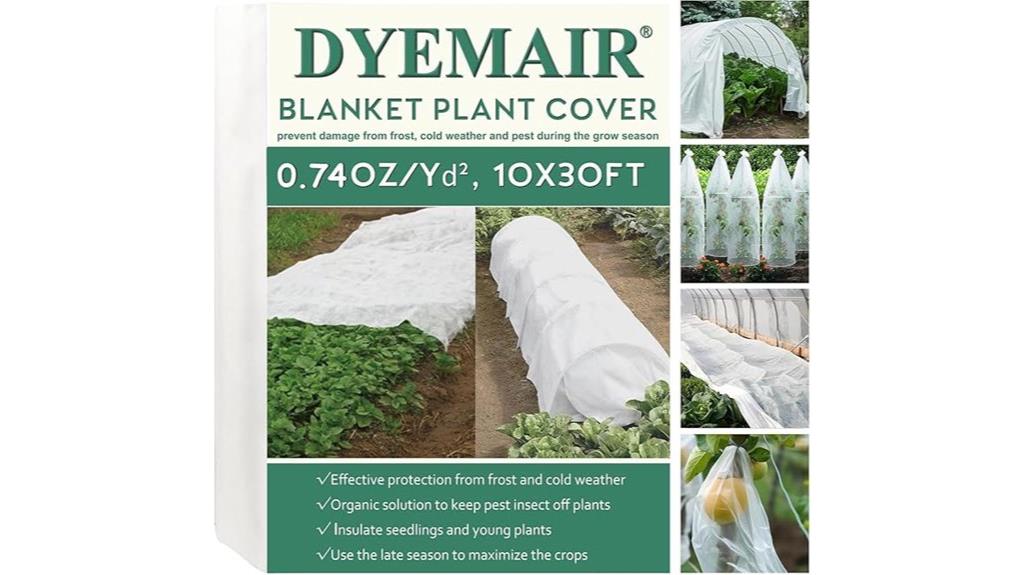
Designed specifically for gardeners looking to protect their plants from frost and harsh weather, the Plant Covers Freeze Protection Frost Cloth offers an effective solution with its generous size of 10 feet by 30 feet. Made from lightweight polypropylene, it lets in 75% light while providing insulation down to 35°F. I've found it perfect for extending the growing season of various crops, from strawberries to peppers. Plus, it's reusable and easy to clean! While I recommend securing it well on windy days, this frost cloth has become an essential part of my gardening toolkit, keeping my plants safe and healthy through unpredictable weather.
Best For: Gardeners seeking an effective and reusable solution for protecting plants from frost and harsh weather conditions.
Pros:
- Provides insulation down to 35°F while allowing 75% light transmission for healthy plant growth.
- Large size (10 x 30 FT) can cover a wide area and be cut to fit various shapes and needs.
- Reusable and easy to clean, making it a cost-effective choice for multiple growing seasons.
Cons:
- Lightweight design may require additional fasteners to prevent it from blowing away in windy conditions.
- Some users in colder climates may prefer thicker options for better insulation.
- The effectiveness may vary based on regional climate conditions, with some users finding it less adequate in extreme cold.
Plant Covers Freeze Protection, 10Ft x 30Ft Reusable Floating Row Cover
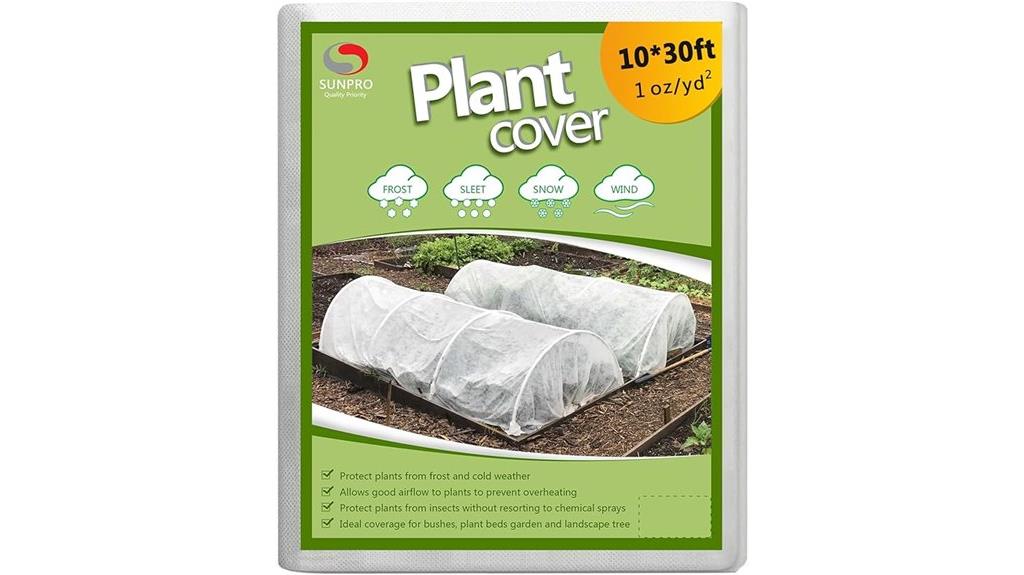
If you're looking to protect your plants from harsh weather while maximizing their growth potential, the 10Ft x 30Ft Reusable Floating Row Cover is a fantastic choice. This cover's lightweight, breathable polypropylene fabric effectively retains warmth while keeping pests out. I appreciate how it allows rain and irrigation to nourish my plants without hindrance. Plus, it's perfect for insulating strawberries, herbs, and tender plants, extending my growing season into early spring and late fall. While it's durable, I've noticed it can be less sturdy in heavy winds. Overall, it's a reliable investment for consistent, seasonal protection.
Best For: Gardeners looking for effective frost protection and extended growing seasons for delicate plants.
Pros:
- Lightweight and breathable material allows for effective warmth retention while keeping pests out.
- Versatile design enables rain and irrigation to nourish plants without obstruction.
- Reusable and durable, providing reliable protection season after season.
Cons:
- May be less sturdy in high winds, potentially compromising effectiveness.
- Some users have reported durability concerns in areas with heavy snowfall.
- Installation can be straightforward, but improvements for sturdiness may be needed according to feedback.
Plant Covers for Frost Protection (10FT X 30FT)
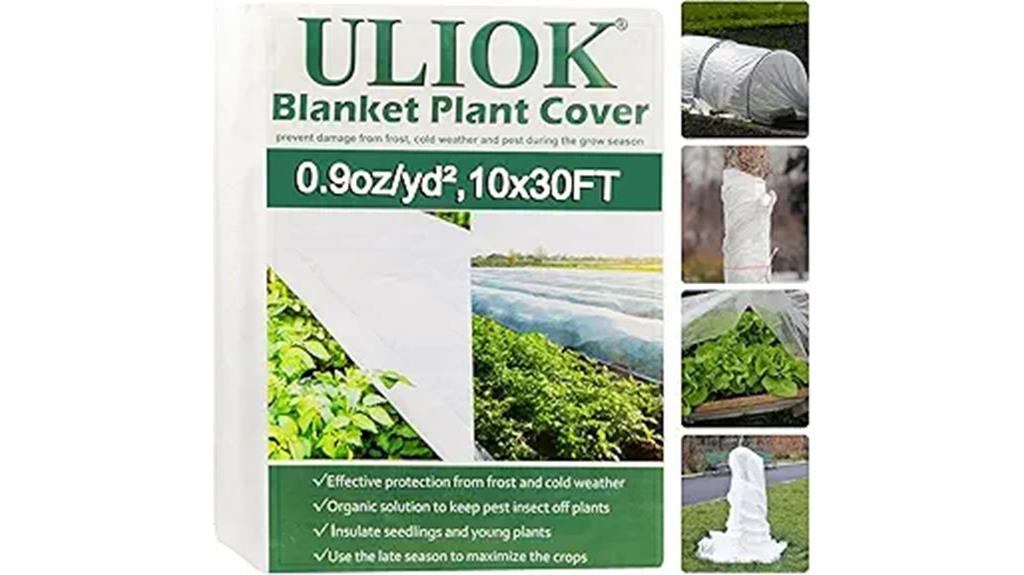
For gardeners looking to protect their plants from frost, the 10FT x 30FT plant cover offers an ideal solution. Made from durable, non-woven polypropylene fabric, it withstands temperatures as low as 35°F while letting in 75% of light. This cover shields your plants from harsh weather, UV damage, and pesky critters. I love how it creates a warm environment for seedlings, boosting growth and crop yields. Plus, it's reusable—just clean it up and store it for next season. Just remember to secure it with stakes or bricks to keep it stable against wind and snow.
Best For: Gardeners seeking effective frost protection for their plants during colder months.
Pros:
- Durable non-woven polypropylene fabric that withstands temperatures as low as 35°F.
- Creates a warm environment conducive to seed germination and healthy growth.
- Reusable and can be easily cleaned and stored for multiple seasons.
Cons:
- May not provide sufficient protection in temperatures below 30°F; caution is advised.
- Requires securing with stakes or bricks to prevent instability in windy conditions.
- Mixed reviews on effectiveness, with varying user experiences reported.
Factors to Consider When Choosing Row Cover Materials
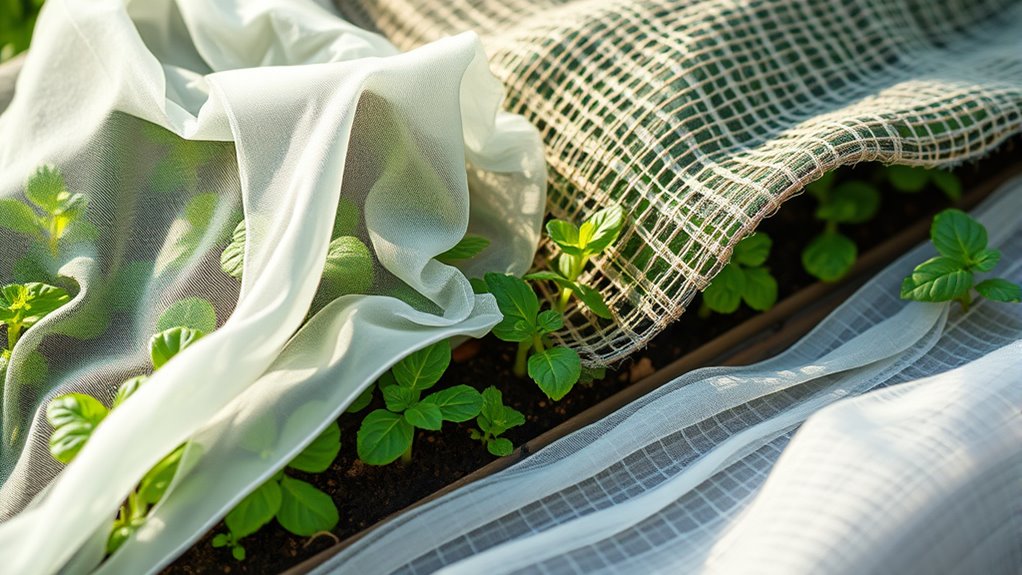
When I choose row cover materials, I consider several key factors to guarantee my plants thrive. Durability, breathability, and temperature resistance are just a few aspects I keep in mind. I also look for versatility and ease of installation to make my gardening experience smoother.
Material Durability and Weight
Choosing the right row cover material isn't just about protection; it also hinges on durability and weight. I've noticed that lighter fabrics, like 0.55 oz/sq, are great for breathability but might not hold up against harsh weather. Heavier options, around 1.0 oz/sq, offer better protection in extreme conditions and resist wear and tear, which means they can last for multiple growing seasons. I also pay attention to UV resistance; high-quality fabrics should withstand sunlight for 3-5 years without degrading. Additionally, the tensile strength matters—stronger materials perform better in windy areas. Finally, I find that proper maintenance and storage, like cleaning and drying before storing, can really enhance the durability of my row covers over time.
Breathability and Light Transmission
After considering durability and weight, breathability and light transmission are next on my list of priorities for row cover materials. I've learned that breathability is essential because it lets air and moisture reach my plants, promoting healthy growth and preventing mold. Equally important is light transmission, which fuels photosynthesis; I aim for fabrics that allow 70% to 95% light. Non-woven polypropylene fabrics are my go-to choice since they strike a balance between breathability and light while protecting against pests and frost. I also keep in mind that thinner materials typically offer better breathability but might lack insulation. By focusing on ideal breathability and light transmission, I can boost seed germination rates and overall plant vigor in various growing conditions.
Temperature Resistance and Insulation
While evaluating row cover materials, I find temperature resistance and insulation to be essential factors that can markedly impact plant health. The thickness and weight of fabrics, like 0.55 oz/sq and 1.0 oz/sq, determine their insulation capabilities. Lightweight covers are great for extending the growing season, protecting plants from temperatures as low as 35°F while allowing air and moisture to pass through. On the other hand, heavier fabrics excel at shielding plants against extreme cold, frost, and snow, making them ideal for winter use. I also appreciate breathable materials that create a warm microclimate, promoting germination and seedling growth. Consider design features like layered applications or hoops, as they enhance insulation while ensuring plants can breathe.
Versatility for Various Plants
Understanding how row cover materials insulate plants naturally leads me to contemplate their versatility for various types of plants. I've found that these covers protect everything from tomatoes and peppers to flowers and shrubs, shielding them from harsh weather. They create a warm, humid environment that encourages seed germination, making them perfect for both spring and fall planting. The lightweight, breathable materials let air, moisture, and sunlight in, supporting healthy growth while keeping pests and extreme temperatures at bay. I love that many row covers can be cut to size, adapting easily to my garden's unique needs. They're useful for frost protection in winter and sun shading during hot summer months, proving their all-around value.
Ease of Installation and Use
When choosing row cover materials, ease of installation and use is a top priority for many gardeners. I've found that lightweight options, like non-woven polypropylene fabric, make setup a breeze. You can simply drape these covers over your plants and secure them with soil, stones, or staples. If you prefer a little more structure, some row covers can be supported with hoops, allowing your plants to breathe while staying protected. I love that many materials can be customized, letting me cut them to fit specific sizes for different plants. Plus, breathable fabrics let air and moisture through without needing daily removal, which simplifies maintenance and keeps my plants healthy. Overall, these features make row covers incredibly user-friendly.
Cost-Effectiveness and Longevity
After considering ease of installation and use, it's important to evaluate the cost-effectiveness and longevity of row cover materials. I've found that comparing the initial investment against how long a material lasts is essential. Some fabrics can last 3-5 years with proper care, making them worthwhile. While higher-quality options like heavy-duty polypropylene might cost more upfront, they offer better durability, reducing the need for replacements. On the other hand, lightweight covers may seem cheaper but often require more frequent replacement, especially in harsh climates. Investing in reusable covers pays off over time, as they can be cleaned and stored for future seasons. Ultimately, choosing materials with good UV resistance and tear strength enhances their longevity and value.
Frequently Asked Questions
How Do I Determine the Right Size of Row Cover for My Plants?
To determine the right size of row cover for my plants, I measure the height and width of each plant, adding a bit of extra space for coverage. I also consider the area I want to protect, ensuring the cover can accommodate any growth. I usually give myself a few extra inches on each side, so I can secure it properly. It's all about providing enough room while keeping my plants safe!
Can Row Covers Be Reused After a Growing Season?
Did you know that about 30% of garden waste comes from discarded materials? I always try to minimize waste, so I reuse my row covers whenever possible. After a growing season, I inspect them for tears or stains, and if they're in good shape, I fold them up for next year. They've protected my plants well, and reusing them not only saves money but also helps the environment. It's a win-win!
What Temperatures Can Row Covers Protect Against?
When I use row covers, I find they can protect my plants from temperatures as low as 28°F (-2°C). They create a microclimate, keeping the warmth in while shielding against frost. I've noticed that even on chilly nights, my plants thrive beneath them. However, I've also learned that if temperatures rise too much, I need to vent or remove the covers to prevent overheating. Balancing their use is key for success!
How Do I Secure Row Covers to Prevent Wind Damage?
To secure row covers and prevent wind damage, I use a few simple techniques. First, I weigh down the edges with rocks or soil to keep them in place. I also use stakes or hoops to create a sturdy framework, which helps maintain the cover's position. If I'm expecting strong winds, I'll add additional ties or clips. This way, my plants stay protected, and I don't have to worry about the covers blowing away.
Are There Any Eco-Friendly Options for Row Cover Materials?
When it comes to protecting our plants, eco-friendly options are like a welcome change. I've found that using materials like organic cotton, jute, or even recycled plastic can work wonders. These options not only shield my plants from harsh weather but also reduce environmental impact. Plus, they're biodegradable! So, if you're looking for sustainable choices, I'd definitely recommend exploring these alternatives for your garden's needs.
Conclusion
In the garden, row covers are like cozy blankets for your plants, shielding them from the harsh elements while fostering growth. With a variety of materials at your disposal, choosing the right one can make all the difference in your gardening success. Whether you need protection from frost, pests, or weeds, there's a perfect row cover waiting for you. So, gear up and give your plants the care they deserve; they'll thank you with bountiful harvests!
